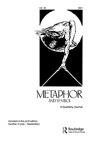The Indexical Affordance of Metaphor: Stain as a Case Example
IF 3.3
3区 文学
0 LANGUAGE & LINGUISTICS
引用次数: 0
Abstract
ABSTRACT This paper investigates an unexplored indexical dimension inherent in the mapping structure of metaphor. The empirical focus is on the metaphor of stain but the scope of indexicality in relation to metaphor might be on a more general level. Based on analyses of a political statement as well as transcripts from a therapy session it is argued that previous accounts on the stain metaphor within CMT are insufficient and only covers parts of the cognitive structures and social aspects of the metaphor. Hitherto, the stain metaphor has been analyzed as part of a larger framework on moral reasoning related to the conceptual metaphors GOOD IS CLEAN, BAD IS DIRTY. This cognitive schema relies on a dichotomy between clean and dirty objects claiming that we understand and experience unmoral, or socially unacceptable behaviors in terms of (interaction with) dirty or filthy objects. However, the analyses in this paper clarify that this account only addresses one dimensions of stains, that is, their tendency to be perceived as dirt, and thereby misses their status as traces or signs. Thus, the accounts offered by CMT miss the fundamental indexical constraints of the stain expression. The source domain of physical stains is in itself constrained by a relation of contiguity (spatiotemporal proximity and association) between the stain and the actions leading to the stain. Thus, in a single expression, the stain metaphor indicates temporal and causal relations in an easily accessible way. Further, the figurative use of “stain” can also be captured as a EFFECT FOR CAUSE metonymy allowing for an intuitive sense of causal relations as well. The central claim of the paper is that metaphor research needs to pay closer attention the kinds of perception of reality that metaphors make possible in-and-through their indexical constraint.隐喻的索引能力:以污点为例
摘要本文研究了隐喻映射结构中一个未开发的索引维度。实证研究的重点是污点隐喻,但与隐喻相关的索引性范围可能在更一般的层面上。基于对一篇政治声明的分析以及一次治疗过程的记录,我们认为先前关于CMT中污点隐喻的描述是不充分的,并且只涵盖了隐喻的部分认知结构和社会方面。到目前为止,污物隐喻一直被作为道德推理的一个更大框架的一部分来分析,这个框架与概念隐喻“好是干净的,坏是肮脏的”有关。这种认知模式依赖于干净和脏的物体之间的二分法,声称我们理解并经历了不道德的,或社会上不可接受的行为,就(与)脏或脏的物体的互动而言。然而,本文的分析澄清说,这种说法只涉及污渍的一个方面,即它们被视为污垢的倾向,从而错过了它们作为痕迹或标志的地位。因此,CMT提供的解释错过了染色表达的基本索引约束。物理污渍的源域本身受到污渍和导致污渍的行为之间的邻近关系(时空接近和关联)的约束。因此,在一个单一的表达中,污点隐喻以一种容易理解的方式表明了时间和因果关系。此外,“污渍”的比喻用法也可以被捕获为因果转喻,允许对因果关系的直观感觉。本文的中心主张是隐喻研究需要更加关注隐喻在其索引约束下可能产生的各种现实知觉。
本文章由计算机程序翻译,如有差异,请以英文原文为准。
求助全文
约1分钟内获得全文
求助全文
来源期刊

Metaphor and Symbol
Multiple-
CiteScore
2.90
自引率
0.00%
发文量
23
期刊介绍:
Metaphor and Symbol: A Quarterly Journal is an innovative, multidisciplinary journal dedicated to the study of metaphor and other figurative devices in language (e.g., metonymy, irony) and other expressive forms (e.g., gesture and bodily actions, artworks, music, multimodal media). The journal is interested in original, empirical, and theoretical research that incorporates psychological experimental studies, linguistic and corpus linguistic studies, cross-cultural/linguistic comparisons, computational modeling, philosophical analyzes, and literary/artistic interpretations. A common theme connecting published work in the journal is the examination of the interface of figurative language and expression with cognitive, bodily, and cultural experience; hence, the journal''s international editorial board is composed of scholars and experts in the fields of psychology, linguistics, philosophy, computer science, literature, and media studies.
 求助内容:
求助内容: 应助结果提醒方式:
应助结果提醒方式:


